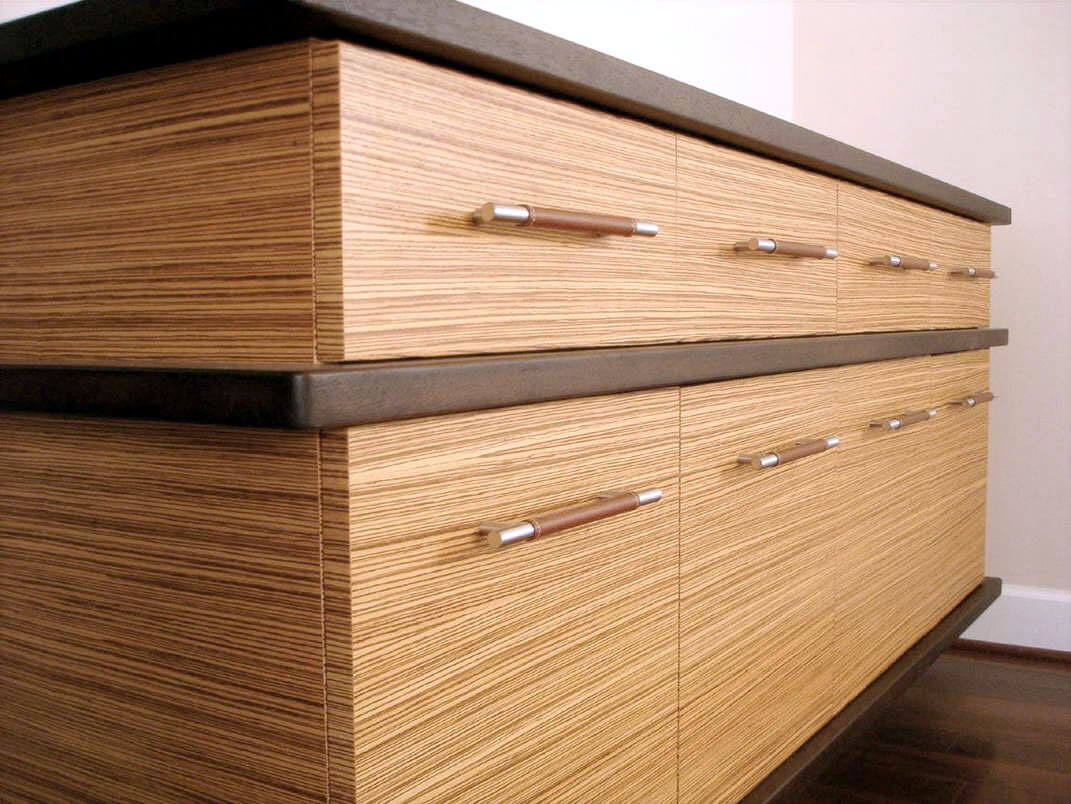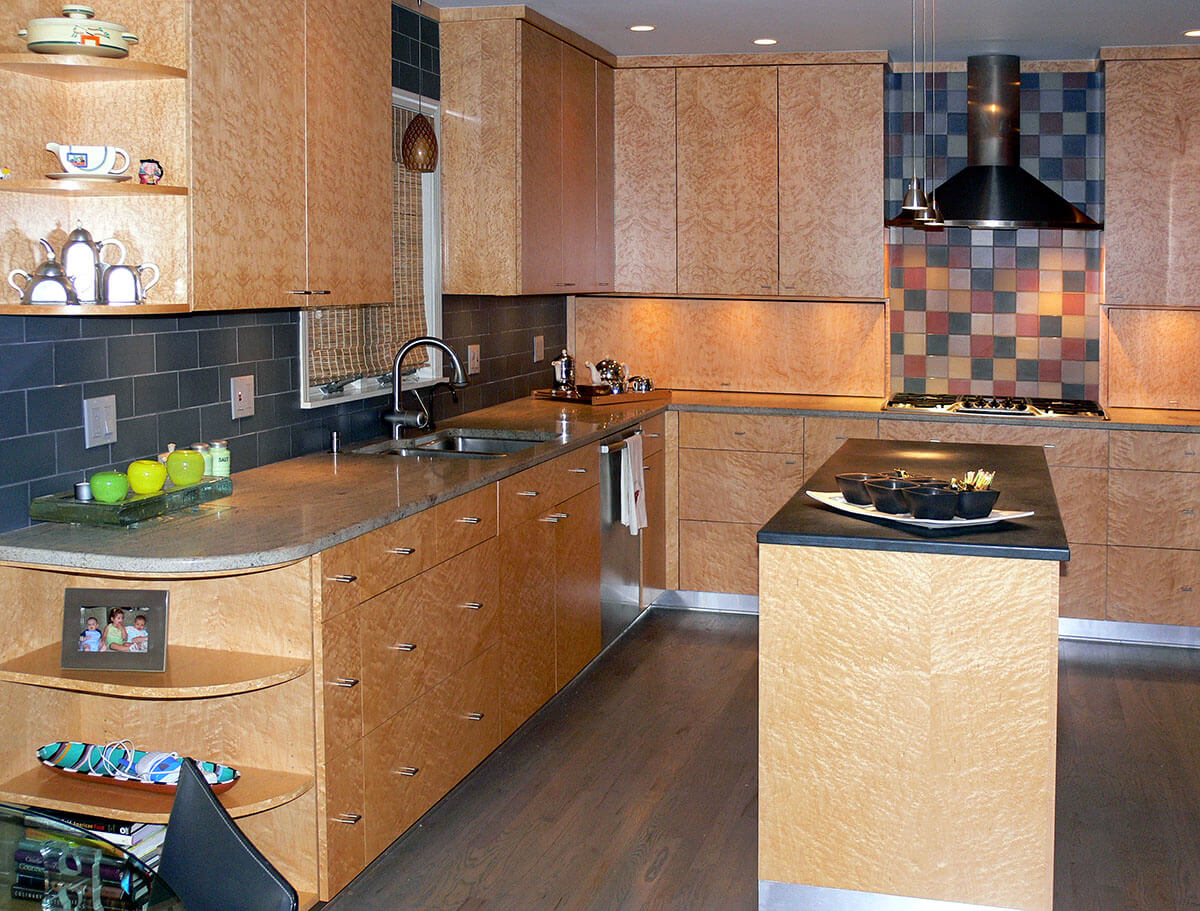Understanding Wood Veneer and Solid Wood Cabinets: Wood Veneer Cabinets Vs Solid Wood

Choosing between wood veneer and solid wood cabinets is a significant decision for any homeowner. Both offer unique benefits and drawbacks, making it crucial to understand the differences before making a choice.
Construction Process of Wood Veneer Cabinets
Wood veneer cabinets are constructed using thin slices of wood, known as veneers, that are adhered to a core material. This core can be made from various materials, such as plywood, particleboard, or medium-density fiberboard (MDF). The veneer provides the aesthetic appeal of real wood, while the core offers structural support.
- The process begins with the selection of high-quality wood for the veneer. This wood is then sliced into thin sheets, typically 1/40th to 1/10th of an inch thick.
- The veneer is then carefully glued to the core material using specialized adhesives. This process ensures a strong bond between the veneer and the core.
- Once the veneer is adhered, the cabinet is constructed using standard woodworking techniques. This may involve cutting, shaping, and assembling the cabinet components.
- Finally, the cabinet is finished with a protective coating, such as paint or varnish, to enhance its durability and aesthetic appeal.
Construction Process of Solid Wood Cabinets
Solid wood cabinets are crafted entirely from solid wood, without any core material. This means that the cabinet’s structure is made from a single piece of wood, ensuring consistent grain patterns and durability.
- The construction of solid wood cabinets typically begins with selecting high-quality wood that is free from defects. This wood is then cut and shaped to create the desired cabinet components.
- The individual components are then joined together using traditional woodworking techniques, such as mortise and tenon joints or dovetail joints. These techniques ensure strong and durable connections.
- Once the cabinet is assembled, it is typically sanded and finished with a protective coating to enhance its durability and aesthetic appeal.
Comparison of Wood Veneer and Solid Wood, Wood veneer cabinets vs solid wood
Wood veneer and solid wood cabinets have distinct characteristics that influence their performance and cost.
Grain Patterns
- Wood Veneer: Veneer offers a wide range of grain patterns, as it can be sourced from various wood species. However, the grain pattern may not be as consistent as in solid wood, as the veneer sheets are often pieced together.
- Solid Wood: Solid wood cabinets display a consistent grain pattern throughout the entire cabinet. This creates a more cohesive and natural look.
Durability
- Wood Veneer: Wood veneer cabinets are generally less durable than solid wood cabinets. While the veneer provides a beautiful finish, it can be susceptible to scratches, dents, and water damage. The core material’s durability also plays a role in the overall durability of the cabinet.
- Solid Wood: Solid wood cabinets are highly durable and resistant to scratches, dents, and water damage. The solid wood construction provides a strong and robust structure that can withstand wear and tear over time.
Cost
- Wood Veneer: Wood veneer cabinets are generally more affordable than solid wood cabinets. The use of core material and less expensive wood for the veneer makes them a budget-friendly option.
- Solid Wood: Solid wood cabinets are typically more expensive due to the use of high-quality, solid wood throughout the construction. The labor-intensive nature of crafting solid wood cabinets also contributes to the higher cost.
Advantages and Disadvantages of Each Type

Choosing between wood veneer and solid wood cabinets can be a tough decision, as both options offer unique benefits and drawbacks. Understanding the pros and cons of each type will help you make an informed choice that aligns with your budget, style, and long-term needs.
Advantages of Wood Veneer Cabinets
Wood veneer cabinets offer several advantages, making them a popular choice for many homeowners.
- Affordability: Veneer cabinets are generally more affordable than solid wood cabinets. This is because veneer uses a thin layer of real wood, which is applied to a core material like plywood or MDF. This construction method reduces the amount of expensive wood needed, making the cabinets more budget-friendly.
- Variety of Finishes: Wood veneer offers a wide range of finishes and colors, allowing you to achieve various styles. The veneer can be stained, painted, or lacquered to match your existing decor or create a unique look.
- Resistance to Warping: Veneer cabinets are less prone to warping than solid wood cabinets. This is because the veneer is thin and flexible, allowing it to expand and contract with changes in humidity without warping. This makes them a good option for humid climates.
- Stability: Veneer cabinets are known for their stability. The thin veneer layer helps to prevent the underlying core material from expanding and contracting significantly, which can cause warping or cracking.
Advantages of Solid Wood Cabinets
Solid wood cabinets are a premium choice, offering several advantages over veneer cabinets.
- Longevity: Solid wood cabinets are extremely durable and can last for generations if properly cared for. The natural strength and resilience of solid wood make it resistant to scratches, dents, and other forms of damage.
- Superior Craftsmanship: Solid wood cabinets are often handcrafted with meticulous attention to detail. The use of solid wood allows for intricate designs and unique finishes, adding a touch of luxury to your kitchen or bathroom.
- Refinishing Potential: Solid wood cabinets can be refinished multiple times, allowing you to update their look as your style evolves. You can change the color, stain, or finish to create a new look without replacing the entire cabinet.
- Value Appreciation: Solid wood cabinets can appreciate in value over time, especially if they are made from high-quality wood species. This can be a significant benefit if you plan to sell your home in the future.
Disadvantages of Wood Veneer Cabinets
While veneer cabinets offer several advantages, they also have some drawbacks.
- Susceptibility to Damage: Veneer cabinets are more susceptible to damage than solid wood cabinets. The thin veneer layer can be easily scratched, chipped, or dented, especially if it is not properly sealed or protected.
- Potential for Delamination: Veneer cabinets can delaminate over time, especially if they are exposed to excessive moisture or heat. Delamination occurs when the veneer layer separates from the core material, resulting in a damaged cabinet.
- Limited Refinishing Options: Veneer cabinets can be refinished, but the options are limited compared to solid wood cabinets. The thin veneer layer may not allow for multiple refinishing cycles, and the finish may not be as durable as a solid wood finish.
Disadvantages of Solid Wood Cabinets
Solid wood cabinets come with several drawbacks that you should consider before making a purchase.
- Higher Cost: Solid wood cabinets are significantly more expensive than veneer cabinets. This is due to the high cost of solid wood and the labor involved in crafting these cabinets.
- Susceptibility to Moisture Damage: Solid wood is susceptible to moisture damage, which can cause warping, cracking, and mold growth. It’s essential to maintain a stable humidity level in your home to prevent moisture damage to your solid wood cabinets.
- Potential for Warping: Solid wood cabinets can warp over time, especially if they are exposed to extreme temperatures or humidity changes. Warping can affect the functionality and aesthetics of your cabinets.
Choosing the Right Type for Your Needs

Ultimately, the decision of whether to choose wood veneer or solid wood cabinets comes down to your individual needs, preferences, and budget. Both options offer distinct advantages and disadvantages, and understanding these differences can help you make an informed decision that aligns with your project goals.
Comparing Wood Veneer and Solid Wood Cabinets
To better understand the key differences between wood veneer and solid wood cabinets, let’s compare them across several important factors:
| Factor | Wood Veneer | Solid Wood |
|---|---|---|
| Cost | Generally more affordable | Typically more expensive |
| Durability | Durable, but susceptible to damage if veneer is compromised | Highly durable and resistant to damage |
| Style | Offers a wide range of styles and finishes | Provides a classic and timeless look |
| Maintenance | Requires regular cleaning and care to prevent veneer damage | Requires regular cleaning and occasional refinishing |
Suitable Applications for Wood Veneer Cabinets
Wood veneer cabinets can be a practical and stylish choice for various applications, especially in situations where moisture exposure or budget constraints are a concern.
- Kitchens with High Humidity: Wood veneer cabinets are generally more resistant to moisture damage than solid wood cabinets, making them a suitable option for kitchens with high humidity levels.
- Bathrooms with Frequent Moisture Exposure: Similar to kitchens, wood veneer cabinets can withstand moisture exposure in bathrooms, offering a cost-effective alternative to solid wood.
- Smaller Spaces: Due to their lighter weight, wood veneer cabinets are a good choice for smaller spaces, minimizing the strain on walls and floors.
- Budget-Friendly Projects: Wood veneer cabinets are often more affordable than solid wood, making them a practical option for those working within a tight budget.
Scenarios Where Solid Wood Cabinets are Preferred
Solid wood cabinets offer a premium look and feel, making them ideal for projects where durability, longevity, and a classic aesthetic are paramount.
- High-End Kitchens: Solid wood cabinets are a staple in high-end kitchens, adding a touch of luxury and sophistication to the space.
- Dining Rooms: Solid wood cabinets are perfect for dining rooms, providing a timeless and elegant backdrop for formal gatherings.
- Libraries: The rich, warm tones and classic style of solid wood cabinets create a welcoming and sophisticated atmosphere in libraries.
- Heritage Homes: For heritage homes, solid wood cabinets seamlessly blend with the existing architectural style, preserving the historical charm of the space.
Decision-Making Process Flowchart
To guide you through the decision-making process, consider the following flowchart:
- Define your budget: Determine how much you are willing to spend on cabinets.
- Assess your needs: Consider the level of moisture exposure, desired durability, and aesthetic preferences for your space.
- Evaluate the pros and cons: Weigh the advantages and disadvantages of wood veneer and solid wood cabinets based on your specific needs.
- Make an informed decision: Choose the cabinet type that best aligns with your budget, needs, and preferences.
Wood veneer cabinets vs solid wood – The debate between wood veneer cabinets and solid wood often hinges on aesthetics and budget, just like choosing between a spacious suburban home and a cozy one-bedroom apartment in a bustling city like Columbus, Ohio. For those seeking a vibrant city life, exploring one bedroom apartments downtown columbus ohio might be a more fitting choice, just as opting for wood veneer cabinets can offer a stylish and cost-effective solution for those who prioritize visual appeal over pure materiality.
Ultimately, the decision boils down to personal preferences and priorities, whether it be for a home or for the cabinets within it.
The debate between wood veneer cabinets and solid wood often hinges on practicality and aesthetics. While solid wood exudes a timeless charm, veneer offers a more affordable alternative, allowing for greater design flexibility. And speaking of design, why not consider adding a touch of whimsy to your bedroom with cool murals for bedrooms ?
These vibrant works of art can transform a space, much like the intricate patterns of wood veneer can add depth to a cabinet. Ultimately, the choice between veneer and solid wood depends on your individual needs and preferences, but remember, a little creative flair can go a long way in making your home truly unique.